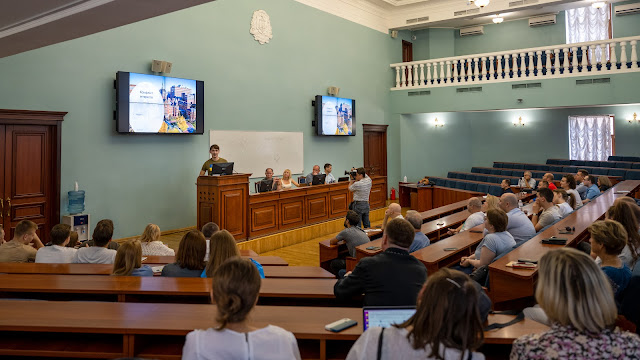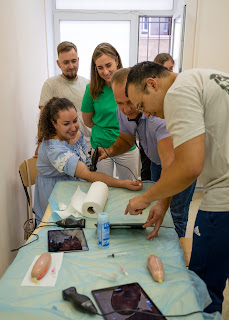USU Alumnus Aids Ukraine Through Medical Education Mission
By Ron L. White, USU Class of 2000
[Editor’s Note: Army Lt. Col. (Dr.) Ron L. White, a Class of 2000 graduate from the Uniformed Services University’s (USU) School of Medicine, and an anesthesiologist and pain management specialist in Germany, recently participated in a volunteer medical education mission to Ukraine. This is his firsthand account.]
Kinetic warfare in Europe – the first in many decades – between Russia and Ukraine has changed the world. Energy, food, and fertilizer shortages are ubiquitous while the Ukrainian civilians are forced to deal with the devastation foisted upon them. The battlefields have shifted continuously, complicated by the fog of war adding additional challenges for those wanting to help the suffering.
Wanting to help however possible, Oleg Turkot, M.D., a close family friend of mine, planned a medical education mission to Ukraine, and launched a social media campaign that raised funds and equipment (portable ultrasound devices, video laryngoscopes, bronchoscopes and others) for the mission.
Turkot is a Ukrainian American anesthesiologist from Johns Hopkins Medical Center who sub-specializes in pain medicine and obstetric anesthesia, as well as a part-time humanitarian who has worked with Kybele International on obstetric anesthesia concerns around the world.
 |
| Dr. Oleg Turkot gives a lecture on Ultrasound Guided Nerve Blocks at Bogomolets National Medical University in Kyiv. (Photo courtesy of Dr. Ron White) |
A team of medical volunteers consisting of six American physicians including myself, one Ukrainian physician, and one anesthesia technician set out from various locations (Oklahoma, Germany, Baltimore, northern California and Kyiv) with crates of gear totaling more than $250,000.00 and grouped together in Warsaw, Poland, the evening of August 19, 2022.
Once the team and equipment were assembled, we set out on a long, rickety van ride heading southeast to the border on our way to Lviv Clinical Municipal Communal Emergency Hospital. We would arrive the next day, beginning our educational training mission with a focus on trauma patient assessment and treatment, as well as practicing obstetric anesthesia and internal medicine processes. We trained hospital staff and resident physicians along with physicians in the greater Roztochia Upland area.
We departed Lviv for Ternopil State Military Hospital to lecture and conduct hands-on workshops the following day. That next day, Aug. 25, our team would conduct the first two Stellate Ganglion Blocks (SGB) for PTSD in Ukraine’s history, on a veteran and a service member.
In the night, we found ourselves boarding a rumbling, Soviet-era train for a 12-hour “blackout” trip to Kyiv. I shared a cabin with a stranger – a jovial giant of a man who turned out to be a Chernobyl survivor. We arrived in Kyiv the next morning, met by an OB/GYN physician and a flat tire.
 |
| Dr. Ronald White explaining the Fluoroscopic findings during a Fluoroscopic Guided Lumbar Sympathetic Nerve Block for Complex Regional Pain Syndrome, CRPS Type II (Photo courtesy of Dr. Ron White) |
In Kyiv, flat tire fixed and with our team back in full force, we visited Bogomolets National Medical University, aka “Ukraine’s Harvard” to lecture and conduct our workshops while veteran non-governmental organizations addressed practice improvement in obstetric anesthesia and internal medicine.
Afterwards we traveled to the eastern edge of Kyiv, past where the Battle of Kyiv had been won, to train the most incredible group of volunteers imaginable, The Knights of the Hospitallers. The Knights are a Roman Catholic Order originating in the Kingdom of Jerusalem as a Catholic Military Order of the Pope in the year 1099. This group of medical professionals had come from around the world to assist the Ukrainian people. Their medics, nurses and doctors were awe-inspiring with their character, bravery, and spirituality. Equipped with donated camouflage-green painted ambulances, Kevlar helmets and body armor, these volunteers would race to the sounds of gunfire to save lives. It was the most humbling of honors to meet, interact and parlay medical knowledge with those brave souls.
One seriously wounded soldier had been hit with shrapnel several months earlier with injuries to both femoral and sciatic nerves, as well as femoral artery and multiple intestinal injuries. Exploratory laparotomy and vascular repair wounds had healed but his recovery had been protracted due to neuropathic pain and subsequent atrophy of his left leg. After a few translated clinical questions, it was clear the patient had Complex Regional Pain Syndrome Type II. Having inadequate relief from nerve pain medication, we discussed medical changes and performance of an L2 Lumbar Sympathetic Nerve block under fluoroscopy. Dr. Strokan had his team move the patient immediately to the operating room as we continued to round. Another service member was clearly suffering from severe PTSD, so he accepted a SGB for PTSD and was also staged for the main operating room.
Dr. Strokan was an amazingly talented anesthesiologist skilled in many fluoroscopic and ultrasound guided interventions and an eager partner in the procedures demonstrated. Since our departure from Ukraine, Dr. Strokan has performed 10 additional SGBs for PTSD and even conducted the first-ever ultrasound guided lumbar sympathetic nerve block for Complex Regional Pain Syndrome (CRPS) on another soldier.
Our time in Kyiv had several other clinical visits to smaller facilities before traveling by train east toward the current battlefront of Dnipro, Ukraine. We were welcomed at the train station by a group of resident physicians to assist with moving gear to Dnipro State Medical University Simulation Center. This was a welcomed surprise. Our location was approximately 60 miles from the front at the time of our arrival which had seemingly endless sounds of air raids. Short one team member at the time, we promoted our assistant who had become proficient with ultrasound venous access to teach that workshop.
We completed our medical education trip on Sept. 2 and it was time to exit the country. One last overnight train ride to Lviv, the cultural hub of Ukraine, then a van back to Warsaw, a taxi to Chopin International Airport, and it was back to the United States.
 |
| Training surrounding Family Practice and Anesthesiologist in the Kyiv region. (Photo courtesy of Dr. Ron White) |
The team for this medical education mission to Ukraine consisted of Oleg Turkot, M.D. (team leader, anesthesiologist, obstetric anesthesiologist, and pain medicine specialist), Liana Turkot, M.D. Ph.D. (internal medicine), Kasia Hampton, M.D. (emergency medicine), Maksym Pylypenko, M.D. (neuro-anesthesiologist), Yuriy Kuybida, M.D. (anesthesiologist), Sergii Alekseiev, M.D. (hospitalist), Benjamin White (anesthesia technician), and myself.
In the end, this team trained approximately 800 physicians, traveled to 12 facilities in four cities, conducted multiple procedures, including several “firsts”.
Having served as an Army anesthesiologist and treated patients in the U.S., Central America, Europe and the Middle East, I must say this was truly one of the incredibly memorable and rewarding events I have experienced. The people of Ukraine are brave and thoughtful, and will undoubtedly conquer this challenge to grow into Eastern Europe’s cultural and economic powerhouse.






